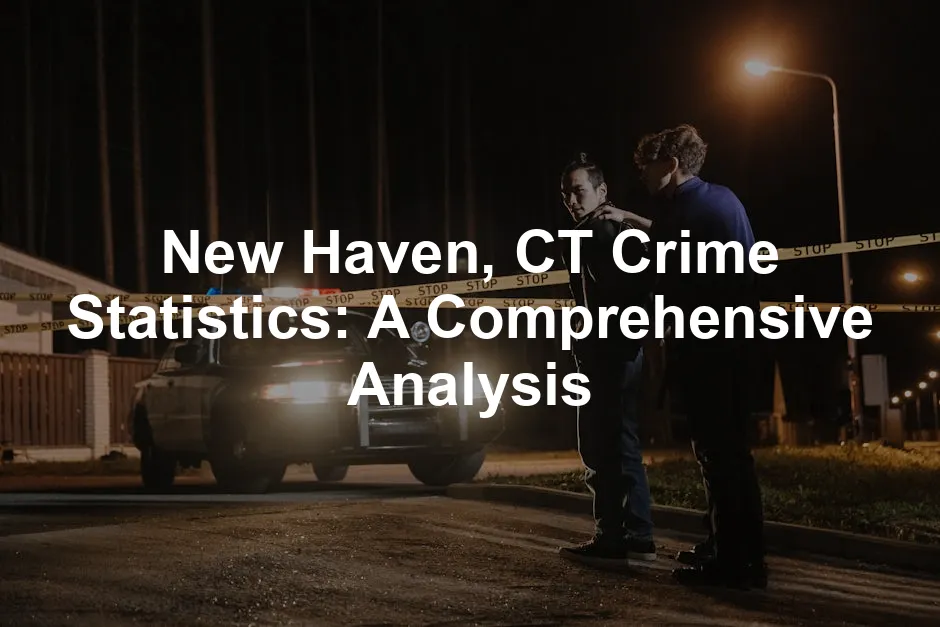Introduction
New Haven, Connecticut, is famous for its rich cultural tapestry and prestigious educational institutions, including Yale University. Nestled along the Long Island Sound, this vibrant city is a hub for arts, innovation, and history. However, while New Haven boasts numerous attractions, it also faces challenges related to crime and safety.
Understanding crime statistics is essential for residents and visitors alike. It helps locals feel more informed and secure in their neighborhoods. For newcomers, it provides insights into what to expect. Whether you’re contemplating a move or planning a visit, knowledge of crime in New Haven is invaluable.
This article aims to provide a detailed examination of crime statistics in New Haven, CT. We’ll compare local data with state and national averages, diving into trends and insights that shed light on the safety of this unique city. By the end, you’ll have a clearer picture of crime in New Haven, empowering you to make informed decisions about living or visiting here.
Before you dive into the stats, consider enhancing your home security with a Home Security Camera System. It’s like having a pair of extra eyes watching over your home—perfect for those late nights when you’re binge-watching your favorite series!
For a deeper understanding of statistical learning and its relevance to data analysis, check out this introduction to statistical learning with Python.
Overview of Crime in New Haven
General Crime Rates
New Haven has a crime rate of 37 incidents per 1,000 residents. This statistic places it among the cities with the highest crime rates in the nation. In fact, over 99% of communities in Connecticut report lower crime rates than New Haven. When you consider the odds, your chance of becoming a victim of crime in this city is roughly 1 in 27. Ouch! That’s a number worth paying attention to.
To put things in perspective, Connecticut’s overall crime rate is much lower, averaging around 14.94 per 1,000 residents. Nationally, the figures also paint a stark contrast, with the average being even lower. New Haven’s crime statistics can seem intimidating, but understanding the context helps residents and visitors navigate the landscape more safely.

To bolster your personal safety, consider a Personal Safety Alarm. It’s a small device that packs a big punch—literally! Pull the pin, and it’ll make a noise loud enough to scare off any unwanted company!
Sources of Data
Accurate crime statistics are crucial for public safety. In New Haven, data comes from reliable sources like the FBI and NeighborhoodScout. These organizations compile information from over 18,000 local law enforcement agencies across the country. The most recent data available reflects the 2022 calendar year, released in October 2023.
Why does this matter? Well, up-to-date crime statistics help law enforcement and community leaders identify trends. They can target resources effectively and adapt strategies to enhance safety. For residents, having access to reliable data aids in making informed decisions about where to live and how to stay safe. Knowing the facts empowers the community to be proactive, rather than reactive, when it comes to ensuring safety.
In summary, crime statistics are more than just numbers; they’re an essential tool for fostering a safer New Haven.

Violent Crime Analysis
Definition of Violent Crimes
Violent crimes are serious offenses that can leave lasting scars on communities. They include:
- Murder and non-negligent manslaughter: The unlawful killing of another person.
- Rape: Non-consensual sexual intercourse or sexual assault.
- Robbery: Taking property from a person through force or intimidation.
- Aggravated assault: An attack that inflicts serious injury or involves a weapon.
Each of these categories highlights the severity of violent crime and its impact on public safety.
Current Statistics
In 2022, New Haven recorded a total of 760 violent crime incidents, which translates to a rate of 5.47 per 1,000 residents. That’s not exactly the kind of headline you’d want to see when flipping through the local news. Here’s how the numbers break down:
- Murder and non-negligent manslaughter: 15 incidents. That’s 15 too many, but it’s a decrease compared to previous years.
- Rape: 48 incidents. While these numbers can be unsettling, they remind us of the work still needed in community safety and support.
- Robbery: 243 incidents. This category shows the need for increased awareness and preventive measures.
- Aggravated assault: 450 incidents. These assaults can have devastating effects on victims and their families.
As you can see, these figures paint a concerning picture of violence in the city. It’s vital to understand these statistics to foster discussions about safety and prevention.

To further protect yourself, consider carrying Pepper Spray. It’s a great way to give yourself an advantage in a tight spot, and it fits easily in your pocket or purse. Safety never looked so stylish!
Comparative Analysis
New Haven vs. Connecticut
When comparing New Haven to the rest of Connecticut, the disparity is glaring. New Haven’s violent crime rate stands at 5.47 per 1,000 residents, which is significantly higher than the state average of 1.5 per 1,000 residents. To put that in perspective, New Haven’s crime rate is more than three times higher than that of the state.
For a broader context, let’s look at nearby cities:
- Hartford: This city has a violent crime rate of 8.1 per 1,000 residents. While still alarming, it’s crucial to note that Hartford’s crime rate is often attributed to its larger population density and socio-economic factors.
- Bridgeport: With a rate of 7.3 per 1,000 residents, Bridgeport also faces challenges similar to New Haven, showing that urban centers in Connecticut grapple with crime.
These comparisons indicate that while New Haven is struggling with its own violent crime issues, it’s not alone. Understanding these trends helps residents and visitors alike to navigate the city with a bit more caution and awareness.
In summary, the landscape of violent crime in New Haven is complex and warrants continuous attention. By staying informed about these statistics, residents can engage in conversations about safety, policy changes, and community initiatives to foster a safer environment for everyone.

Property Crime Analysis
Definition of Property Crimes
Property crimes are offenses that typically involve the theft or destruction of someone else’s property. They can be categorized into three primary types:
- Burglary: This occurs when an individual unlawfully enters a building with the intent to commit a crime, usually theft. Think of it as a not-so-friendly invitation to help yourself to someone else’s belongings, often when they’re not home.
- Larceny (theft): This is the unlawful taking of someone else’s property with the intent to permanently deprive them of it. It’s more than just snatching a cookie from the jar; it’s taking things that belong to others without permission—like that shiny bike you’ve had your eye on.
- Motor vehicle theft: This happens when someone steals a vehicle. Whether it’s a car, truck, or motorcycle, if it’s not yours and you take it, congratulations, you’ve committed motor vehicle theft. No joyrides here!
Understanding these definitions helps residents identify potential risks and stay vigilant in their neighborhoods.

Current Statistics
In 2022, New Haven experienced a total of 4,403 property crime incidents. That translates to a rate of 31.70 property crimes per 1,000 residents. You might want to double-check your locks! Here’s how the data breaks down:
- Burglary: 408 incidents. That’s a lot of unwanted guests, making homeowners rethink their security measures.
- Larceny (theft): 3,199 incidents. This is the most common property crime, reminding us to keep an eye on our belongings, especially in public spaces.
- Motor vehicle theft: 796 incidents. With this number, it’s clear that locking your car isn’t just a suggestion—it’s a necessity.
These statistics paint a vivid picture of property crime in New Haven, highlighting the importance of community awareness and preventive steps.

Consider investing in a Smart Door Lock to enhance your home security. With features like remote access and keyless entry, you can say goodbye to fumbling for your keys while carrying groceries!
Comparative Analysis
New Haven vs. Connecticut
When comparing New Haven’s property crime rate to the broader state of Connecticut, the differences are stark. New Haven’s rate of 31.70 per 1,000 residents far exceeds Connecticut’s state average of 14.94 per 1,000 residents. This means residents in New Haven face a property crime rate more than double that of the state average.
What does this mean for community safety? Higher property crime rates can lead to increased anxiety among residents. People may feel less secure in their neighborhoods, prompting discussions about community initiatives and law enforcement strategies aimed at reducing these figures. Increased crime can also affect property values and insurance rates, making it essential for community members to stay informed and engaged in discussions about safety measures.
In summary, the property crime statistics in New Haven underscore a need for continuous improvement in community safety and a proactive approach to crime prevention. By understanding these numbers, residents can better equip themselves to protect their properties and foster a safer environment for everyone.

Neighborhood Crime Rates
Safest Neighborhoods
New Haven boasts some neighborhoods that shine brighter than others when it comes to safety. If you’re looking for peace of mind, consider these areas:
- Yale University: This neighborhood benefits from a heavy police presence and vigilant community engagement. Students and faculty alike contribute to a lower crime rate, making it a safe haven.
- East Rock: Known for its beautiful parks and family-friendly atmosphere, East Rock sees lower crime rates due to a strong sense of community. Residents often watch out for each other, creating a safer environment.
- Westville: With its charming homes and active neighborhood associations, Westville enjoys a reputation for safety. Community events foster connections among residents, helping to deter crime.
- Fair Haven Heights: This area experiences lower crime rates, thanks to engaged residents and local initiatives aimed at improving safety.
What do these neighborhoods have in common? A mix of community involvement, active law enforcement, and an overall commitment to safety. The residents in these areas prioritize looking out for one another, creating a welcoming and secure environment.

To further enhance neighborhood safety, consider putting up a Neighborhood Watch Sign. It’s a simple yet effective way to deter potential troublemakers and show that you value community safety!
Areas with Higher Crime Rates
On the flip side, some neighborhoods in New Haven face challenges with higher crime rates. Notably:
- Quinnipiac: This neighborhood has struggled with elevated crime rates. Factors contributing to this include socioeconomic challenges and a lack of resources, which can lead to higher instances of property crime.
- Newhallville: Known for its vibrant culture, this area also grapples with crime. Economic disparities and limited access to quality education often correlate with increased criminal activity.
- Dwight: Once a bustling neighborhood, Dwight now faces crime issues that stem from a lack of community programs and economic development.
While these neighborhoods are rich in culture and history, the challenges they face can impact residents’ sense of safety. Addressing these concerns requires a collective effort from the community, law enforcement, and local government to create positive change.

Trends and Changes in Crime Rates
Historical Overview
Looking back over the past decade, New Haven’s crime rates tell a story of ups and downs. From 2012 to 2022, the city has seen a gradual decline in certain violent crimes. For instance, reports of murder have decreased, showcasing community efforts to foster safety. Overall, violent crime rates have seen fluctuations, but the trend is moving in the right direction.
Property crime, however, has remained a concern. While some years showed a decrease, 2022 reported a total of 4,403 property crimes, indicating a need for continued vigilance. Understanding these trends helps residents and city officials assess what strategies are working and what still needs attention.
Factors influencing these trends range from economic conditions to community engagement. Areas with strong neighborhood watch programs often see declines in crime, while regions with socioeconomic challenges struggle more. It’s a complex interplay, but one thing is clear: ongoing efforts are essential for making New Haven a safer place for everyone.

In summary, the historical perspective of crime rates in New Haven highlights the progress made and the challenges that remain. By examining these trends, residents can better understand their neighborhood dynamics and work towards a safer future.
Year-over-Year Changes
When examining crime statistics in New Haven, it’s essential to recognize the year-over-year changes. In recent years, the city has seen fluctuations in specific crime categories. For instance, violent crime incidents totaled 760 in 2022, which reflects a slight increase compared to previous years. Conversely, property crimes showed a decrease, with 4,403 incidents reported in the same year.
Graphs depicting these trends can be quite illuminating. A line graph could illustrate the rise in violent crimes from 2021 to 2022, while a bar graph might effectively display the decline in property crimes over the last several years. Such visuals not only enhance understanding but also provide a clearer picture of crime dynamics in New Haven.

Community Sentiment and Law Enforcement
Public Perception of Safety
Community polls reveal a mixed sentiment regarding safety in New Haven. A recent survey indicated that 63% of residents feel somewhat safe, acknowledging some safety concerns. Meanwhile, 38% rated their safety as pretty safe, indicating a general feeling of security despite noticeable issues.
Local law enforcement’s effectiveness also plays a crucial role in shaping these perceptions. According to the same polls, only 38% of respondents believe that the police are very visible and responsive. Another 38% expressed that while police are visible, their response times can be slow. This perception affects community trust and engagement with law enforcement.

To ensure your safety, consider getting a First Aid Kit. It’s an essential item to have at home or in your car, because you never know when you might need it—whether it’s a minor scrape or a more serious injury!
Law Enforcement Response
Analyzing law enforcement’s effectiveness in New Haven yields interesting insights. The city maintains a police presence with a ratio of about 3.55 officers per 1,000 residents, which is higher than the national average. This presence is bolstered by community policing initiatives aimed at fostering positive relationships between officers and residents.
However, statistics show that crime rates remain concerning, suggesting that a higher police presence alone isn’t a panacea. Efforts to enhance community engagement and focus on preventive measures are crucial. For instance, initiatives that involve local residents in safety programs can improve trust and cooperation between the community and law enforcement.
In summary, community sentiment regarding safety in New Haven reflects a blend of concern and cautious optimism. While law enforcement efforts are underway, ongoing collaboration and proactive measures are essential for fostering a secure environment.

Conclusion
In summary, the crime statistics in New Haven, CT, present a challenging landscape. Violent crime rates have seen a slight uptick, while property crime has declined. Understanding these trends is vital for residents and visitors alike.
The importance of community involvement cannot be overstated. By staying informed and engaged, residents can contribute to improvements in safety. Whether it’s participating in neighborhood watch programs or attending community meetings, every effort counts.
Encouragingly, as residents become more aware and proactive, the potential for enhancing community safety increases. Thus, it’s essential for everyone to remain vigilant and informed about crime trends and safety measures.
FAQs
What is the overall crime rate in New Haven, CT?
The overall crime rate in New Haven stands at 37 per 1,000 residents, significantly higher than the national average. This figure reflects the combined rates of violent and property crimes.
How does New Haven’s crime rate compare to other cities in Connecticut?
New Haven’s crime rate is among the highest in Connecticut, with only a few cities like Hartford and Bridgeport reporting higher rates. Comparatively, the state average is much lower.
What neighborhoods in New Haven are considered the safest?
Safe neighborhoods in New Haven include Yale University, East Rock, Westville, and Fair Haven Heights. These areas benefit from active community engagement and law enforcement presence.
What measures are being taken to reduce crime in New Haven?
Local initiatives focus on enhancing community policing, improving neighborhood watch programs, and fostering collaboration between residents and law enforcement.
How can residents stay informed about crime in their area?
Residents can stay informed by utilizing resources such as local news outlets, community forums, and police department updates. Websites like NeighborhoodScout and City-Data also provide valuable crime statistics and trends.
Please let us know what you think about our content by leaving a comment down below!
Thank you for reading till here 🙂
All images from Pexels




